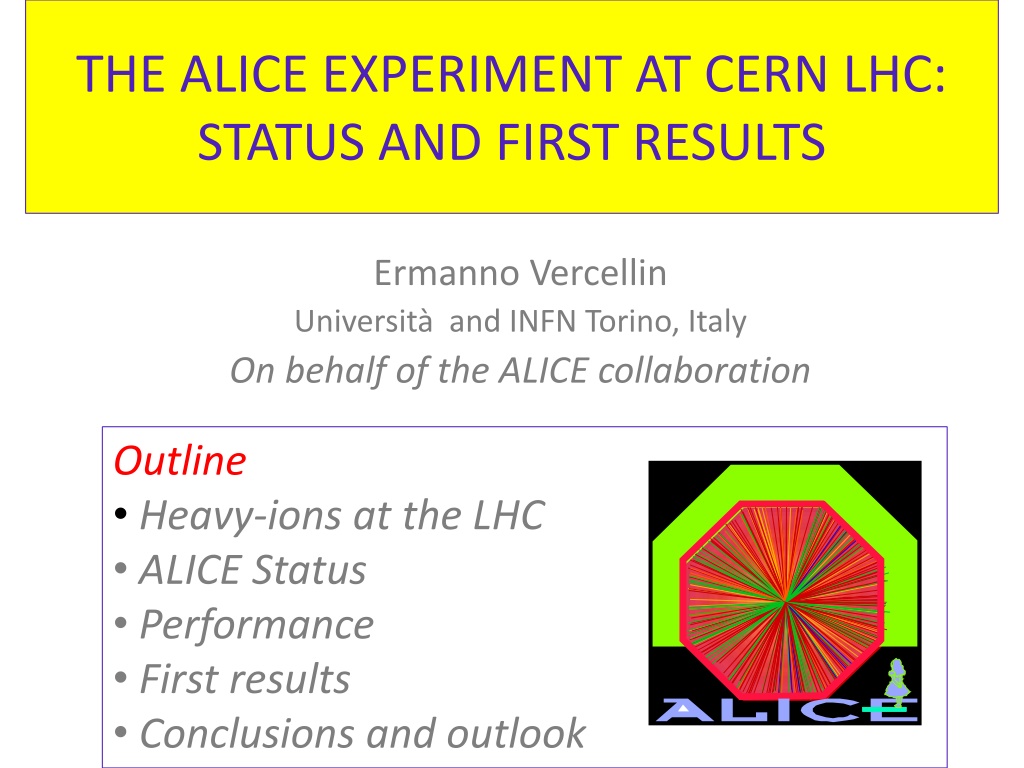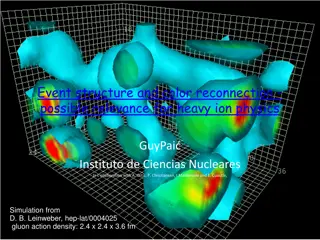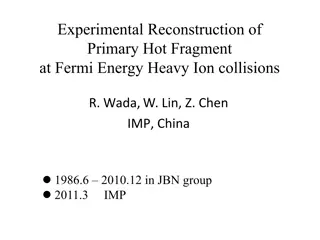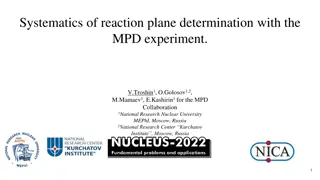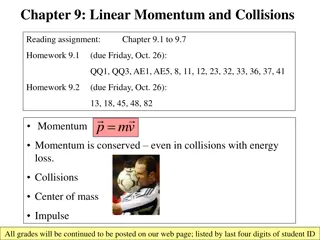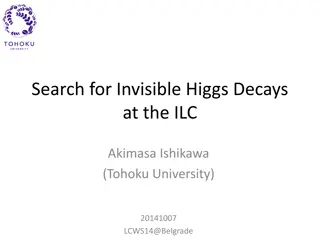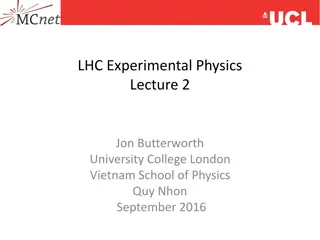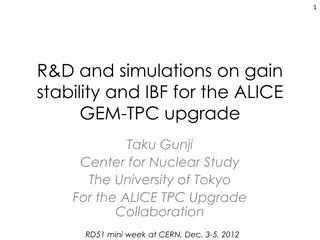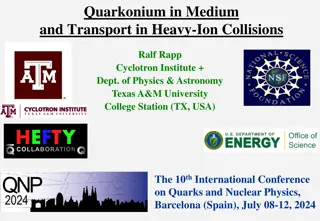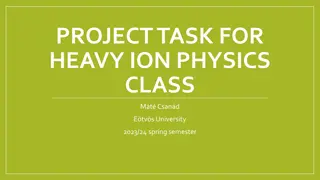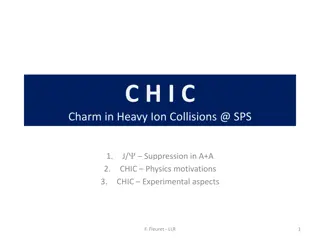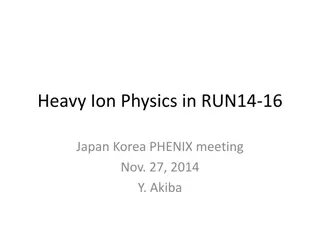Exploring Heavy-Ion Collisions at CERN LHC: ALICE Experiment Overview
Unveiling insights into heavy-ion collisions at CERN's Large Hadron Collider (LHC) through the ALICE experiment. Delving into the status, performance, and initial results, ALICE aims to characterize the medium formed during collisions. With a collaboration of around 1000 members from 31 countries and 110 institutes, ALICE utilizes various detectors to study stable hadrons, leptons, and more, employing cutting-edge techniques for particle identification.
Download Presentation

Please find below an Image/Link to download the presentation.
The content on the website is provided AS IS for your information and personal use only. It may not be sold, licensed, or shared on other websites without obtaining consent from the author. Download presentation by click this link. If you encounter any issues during the download, it is possible that the publisher has removed the file from their server.
E N D
Presentation Transcript
THE ALICE EXPERIMENT AT CERN LHC: STATUS AND FIRST RESULTS Ermanno Vercellin Universit and INFN Torino, Italy On behalf of the ALICE collaboration Outline Heavy-ions at the LHC ALICE Status Performance First results Conclusions and outlook
Heavy ions at the LHC - I SPS RHIC LHC sNN (GeV) dNch/dy 0QGP (fm/c) T/Tc (GeV/fm3) QGP (fm/c) f (fm/c) Vf(fm3) 17 200 5500 500 850 1500-4000 1 0.2 0.1 1.1 1.9 3-4 3 5 15-60 2-4 10 2 ~10 20-30 30-40 few 103 few 104 Few 105 The LHC is the ideal place to study the QGP: hotter - bigger -longer lived Abuntant production of jets and heavy flavors
Heavy-ions at the LHC cc ~ 20 RHIC bb ~ 100 RHIC jets ! Hard probes at the LHC study medium with probes of known mass and colour charge: powerful approach! ALICE GOAL: - Heavy-ion: to measure all the known observables to characterise the medium formed in the collisions - p-p: part of the ALICE physics program, baseline for A-A and intrinsic interest 3
Size: 16 x 26 meters Weight: 10,000 tons Detectors: 18 The collaboration: ~ 1000 members, 31 countries, 110 Institutes
ALICE Acceptance central barrel -0.9 < < 0.9 2 tracking, PID (ITS, TPC, TRD, TOF) single arm RICH (HMPID) single arm em. calo (PHOS) jet calorimeter (charged particles) forward muon arm -4.0 < <-2.5 absorber, 3 Tm dipole magnet 10 tracking + 4 trigger chambers arm multiplicity -3.4 < < 5.1 including photon counting in PMD trigger & timing dets 6 Zero Degree Calorimeters T0: ring of quartz window PMT's V0: ring of scint. Paddles
Particle Identification stable hadrons ( , K, p): 100 MeV < p < 50 GeV dE/dx in silicon (ITS) and gas (TPC) + Time-of-Flight (TOF) + Cerenkov (RICH) dE/dx relativistic rise => extend PID to several 10 GeV decay topology (K0, K+, K-, D+, ) K and decays up to > 10 GeV leptons (e, ), photons, 0 Alice uses ~ all known techniques! muons: p > 5 GeV 0 in PHOS: 1 < p < 80 GeV electrons in TRD: p > 1 GeV /K TPC + ITS (dE/dx) K/p e / /K e / TOF K/p /K HMPID (RICH) K/p 0 1 2 3 4 5 p (GeV/c) TPC (rel. rise) /K/p TRD e / PHOS / /K K/p 1 10 100 p (GeV/c)
ALICE recent history and status Detector installation until July 2009: see next slide for details on the sut-up Cosmic runs (calibration, alignment) from August to mid November 2009. Example: ITS pixel alignment, TOF resolution TOF= / 2 = 88 ps TPC and TRD SPD: initial alignment with cosmics see K. Aamodt et al. (ALICE), arXiv: 1001.0502 (accepted by JINST) Muon spectrometer
p-p data taking: detector configuration ITS, TPC, TOF, HMPID, MUON, V0, To, FMD, PMD, ZDC (100%) TRD (7/18) EMCAL (4/12) PHOS (3/5) at nominal T (-25 C) HLT (60%)
p-p data taking: trigger configuration based on interaction trigger reading all detectors: SPD (min bias) or V0-A or V0-C at least one charged particle in 8 pseudorapidity units and single-muon trigger reading MUON, SPD, V0, FMD, ZDC : single muon, low-pT threshold, in the muon arm in coincidence with interaction trigger activated in coincidence with the BPTX beam pickups: bunch-crossing with bunches from both sides for control bunch-crossing with bunch from side A or C only for control bunch-crossing with no bunches a fraction of bunch-crossing trigger (no condition on trigger detectors) for control to measure relative fractions of single- and double-diffractive events HLT in Mode B (no event rejection)
First p-p collisions and first physics - I 23/11/09 : pp coll. at 900 GeV 14/12/09 : pp coll. at 2.36 GeV March 2010 : pp coll. at 7 TeV INEL = non-diffr. + single-diffr. + double diffr. NSD = non-single-diffractive
First p-p collisions and first physics - II 23/11/09 : pp coll. at 900 GeV 14/12/09 : pp coll. at 2.36 GeV ALICE data similar to those obtained by CMS dN/d is larger and Increases faster with c.m. energy than predicted by generators; best agreement: PYTHIA ATLAS CSC March 2010 : pp coll. at 7 TeV
First p-p collisions and first physics - III The shape of our measured multiplicity distribution is not reproduced by any of the event generators considered. 23/11/09 : pp coll. at 900 GeV 14/12/09 : pp coll. at 2.36 GeV Fits with one NBD work also at all the three energies (0.9, 2.36 and 7 TeV) XX/03/10 : pp coll. at 7 TeV
ALICE running 2009/2010 2009 (0.9 and 2.36 TeV) ~10.3 b-1 2010 (till 1/6) (0.9 and 7 TeV) ALALICE: red ~ 500 k min bias int lumi ~ 20 nb-1 ~ 180 M min bias 13
ALICE performance Tracking TPC-ITS track matching: Probability of the TPC track prolongation in ITS. TPC pt resolution from cosmics: e.g.: at 10 GeV/c 7% (target value ~ 5%) -Details in J. Alme et al. (ALICE TPC), arXiv:1001.1950 (subm. to NIM) SSD: / 2 ~ 18 m ~ intrinsic res. SDD: alignment + drift velocity calibration
ALICE performance Tracking and vertexing Primary vertex efficiency VS multipl. for data and MCs, with and without the constraint on the luminous region. Secondary vertex: transverse impact parameter resolution (TPC track quality cuts and 2 points in SPD). For each track, its impact parameter was estimated with respect to the primary vertex reconstructed without using this track. The resulting resolution is the convolution of the track -position and the primary-vertex resolutions. Spread of the primary vertex (x,y) . Reconstructed with tracks and with SPD only: spread of vertices in data at 7 TeV Asymptotic limit estimates the size of the luminous region.. Vertex finding at work: distributions of event vertices along the beam direction obtained from SPD hits. The lines are from Monte Carlo.
ALICE performance - PID Dependence of the particle velocity measured by TOF on the particle momentum de/dx of charged particles vs. their momentum in the TPC. The lines correspond to the ALEPH parameterization of the Bethe-Bloch curve. dE/dx of charged particles vs their momentum, both measured by the ITS alone
Photons and high momentum PID invariant mass distribution measured EMcal and PHOS High-momentum Particle identification with the HMPID Cerenkov det. EMCal EMCal ALICE work in progress K p PHOS PHOS
Electrons and muons Muon detection in the forward muon spectrometer e/ discrimination in the TRD gain calibration with e+e- K0s + - Tracking-trigger matching efficiency L0 trigger on pt > 0.5 GeV Pt (GeV/c) 18
Meson detection + PDG: 1019.5 MeV
J/ + - invariant mass spectrum as measured by the muon spectrometer . Pseudorapidity interval 2.5< <4.0 and down to zero transverse mom. After first alignment with straight tracks, inv. mass resolution at J peak close to design value. e+e- invariant mass spectrum as measured in the central barrel . Pseudorapidity region -0.9< <0.9
Other papers in advanced stage Charged particle pT distribution Baryon-antibaryon asymmetry Bose-Einstein correlations Strangeness production (K0, , , ) Identified particles ( , K, p) pT distribution
pT-differential (900 GeV) Tsallis fit vs generators 24
<pT> vs multiplicity (900 GeV) vs generators 25
Bose-Einstein Correlations Hambury Brown Twiss correlation for identical bosons ( -) full analysis ready, under internal approval vs charged particle multiplicity and KT 27
Conclusions and Outlook for 2010 ALICE has successfully started the p-p data taking campaign First physics resultes already published, other expected be published soon More to come: 0, c and b production J/ production high multiplicity jet correlations event shape underlying events reconstructed jets b-tagged jets and of course Pb-Pb! 28
ALICE training in view of heavy-ion collisions
